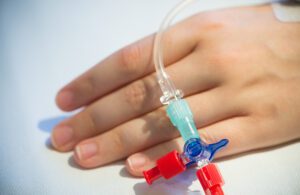From innovative new cancer therapies to pioneering diabetes care, self-lubricating LSRs may be the right choice to efficiently manufacture medical devices that make a life-changing difference in patients’ lives. [Photo courtesy of Avantor]
By Alexander Santayana, Nusil — a brand of Avantor
From well-established biocompatibility to robust performance characteristics, silicone offers medical device manufacturers a unique engineered material ideal for these applications. One type, self-lubricating liquid silicone rubbers (LSRs), provides an excellent medical-grade material that can solve manufacturing challenges and increase device performance.
These elastomers contain a built-in lubricant that, over time, elutes to the molded part’s surface. For medical-grade LSRs, this lubricant offers many of the same properties as the elastomer, such as inertness or biocompatibility. In addition, the lubricant can be formulated so it won’t cause swelling when contacts other silicone elastomers, a process that can create dimensional or even mechanical challenges.
Self-lubricating LSRs are available with varying lubricant levels and can be formulated to meet regulatory guidelines for short- and long-term implant use. These formulations are available off-the-shelf but can also be customized for specific manufacturing or end-use needs.
The characteristics of self-lubricating LSRs make them ideal for minimizing friction at component interfaces to enhance the performance of medical devices, including wearable devices. In addition to components like O-rings and connector gaskets, these elastomers are used in dynamic seals, slit valves, membrane septa and duck-bill valves.
For example, a self-lubricating LSR can be used on a silicone septum in an insulin delivery device to protect the needle, improve reliability and enable consistent performance. The elastomers have also been used in needle-free injection ports to deliver cancer treatments and other life-saving therapies. In these applications, a self-lubricating LSR allows manifolds to move more consistently and smoothly than a typical LSR.
What advantages do self-lubricating LSRs offer medical device designers?

Self-lubricating liquid silicone rubbers (LSRs) provide an excellent medical-grade material that can solve manufacturing challenges and increase device performance. [Photo courtesy of Avantor]
- Reduce time and labor: These elastomers eliminate the need for an extra processing step, like dipping or spraying the component with a lubricant, saving assembly time. In addition, self-lubricating LSRs can improve assembly in applications where sliding components tend to bind.
- Create more reliable performance: Because the lubrication elutes from within, the article’s surface is coated with an even amount of oil. This eliminates the potential for inconsistency that can stem from imprecise or uneven applications, such as undercut or shadowed features that are incompletely lubricated during manufacturing.
- Reduce break-free force: Self-lubricating LSRs reduce the force required to overcome initial resistance to motion, a factor important in an application like when a needle must pierce the skin, remove a blood sample and then retract. By facilitating consistent insertion, the self-lubricating LSR helps make the needle more reliable.
- Resist blocking: Over time, when elastomers contact each other or other materials like metal, they can develop a degree of adhesion. Since self-lubricating LSRs resist blocking, they can help maintain component performance.
- Prevent healing: A silicone component with a slit valve opening can begin to repair itself. Some types of sterilization, particularly gamma, can also initiate healing in silicone membranes. Self-lubricating LSRs will not heal, allowing the valve or other component to function as intended.
How can medical device engineers choose the right self-lubricating LSR?
- Factor in shrinkage: As self-lubricating LSRs elute oil, the rubber component shrinks over time. Engineers will typically factor in molding shrinkage to normal LSRs, but the self-lubricating LSR has a different shrink factor. This is an important consideration when designing a seal that requires critical tolerances, such as an O-ring that relies on highly controlled profiles and geometries.
- Consider sterilization: Typically, self-lubricating LSRs are a good fit for applications that require radiation sterilization. These elastomers resist the blocking, sticking and healing that radiation can trigger in plastics and typical rubbers. If the application requires dry heat sterilization, be aware that the process can cause self-lubricating LSRs to elute additional oil, causing more shrinkage than would be expected from a traditional silicone.
- Understand the risk of migration: During manufacturing, workers who touch oil from this type of LSR risk spreading it to other surfaces. Mitigate this risk by with gloves when handling and regular cleaning. Migration can also impact device performance. For example, the oil from a self-lubricating LSR used on a seal could migrate and interfere with subsequent adhesive processes. In those types of applications, an appropriate, medical-grade silicone grease or a dry lubricious coating may be a more suitable solution.
- Consider fouling: The use of self-lubricating LSRs may require occasional mold cleaning because of their potential to foul tiny features like venting. During the tooling design phase, it’s important to factor in very small features that could be clogged by fouling.
Material selection is essential when designing the next breakthrough. Whether you’re developing an innovative new cancer therapy or pioneering diabetes care, medical-grade self-lubricating LSRs may be the right choice to help you efficiently manufacture medical devices that make a life-changing difference in patients’ lives.

Alex Santayana is an applications engineer with NuSil [Photo courtesy of Avantor]
Alex Santayana, an applications engineer with NuSil, has spent over eight years working in the silicone industry, specializing in the application of silicone materials for growing markets, including high-tech, biomaterials, aerospace, and electronics. Santayana’s broad expertise, including medical-grade materials, provides insight into the design of silicone articles, materials, and processing.
How to join the MDO Contributors Network
The opinions expressed in this blog post are the author’s only and do not necessarily reflect those of Medical Design & Outsourcing or its employees.